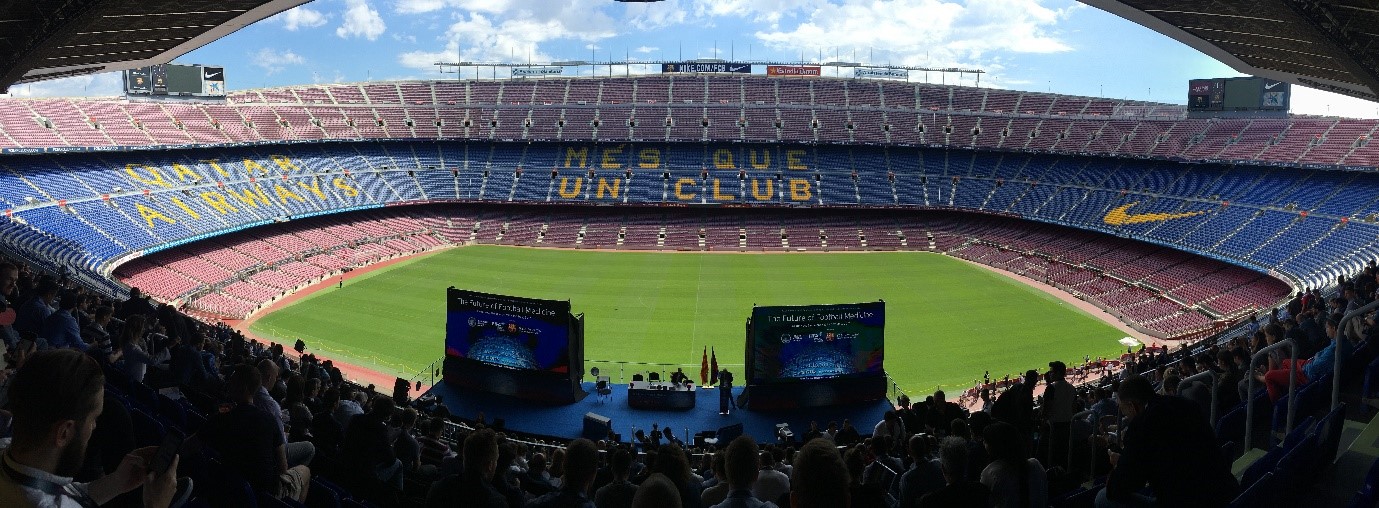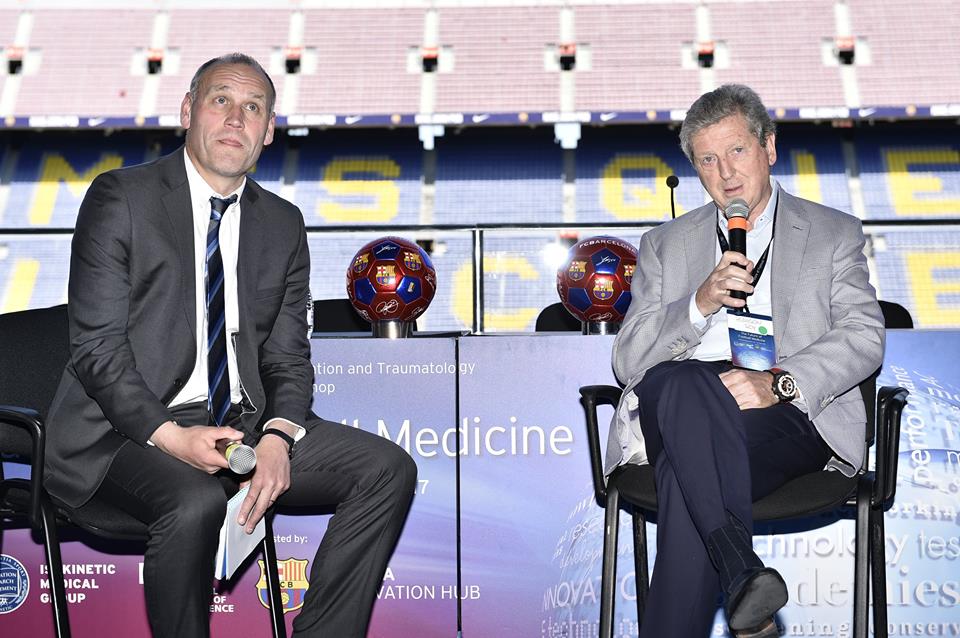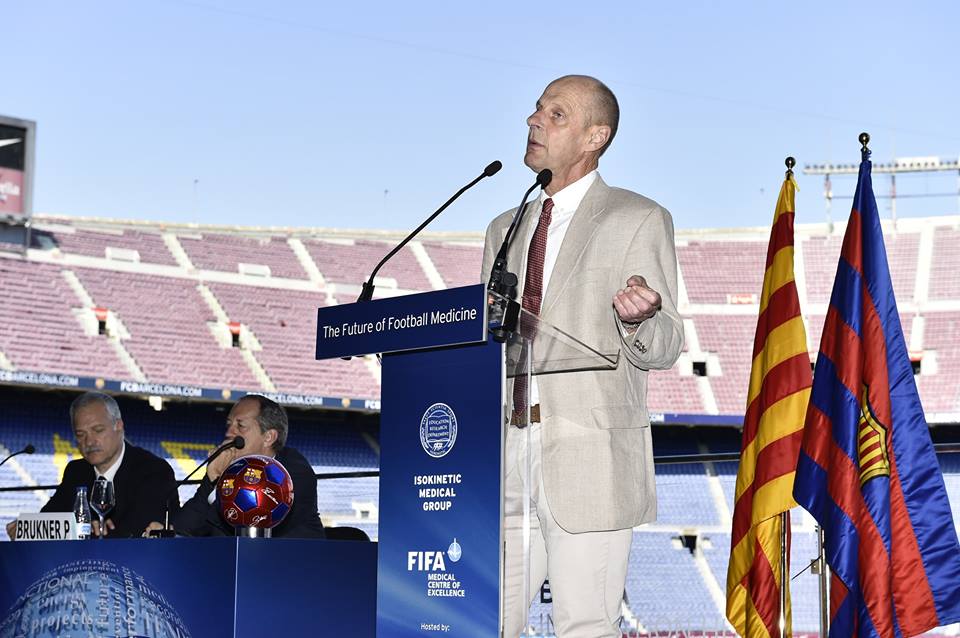By Dr Chris Garnett

On 13-15th May 2017, the largest annual football medicine event in the world took place at the iconic Camp Nou in Barcelona. ‘The Future of Football Medicine’ Conference, organised by the Isokinetic Medical Group in association with FIFA, brought together 2,500 delegates and 197 of the world’s most renowned speakers from 90 different countries. Over the 3 days, researchers, clinicians and sports scientists delivered talks and workshops on the latest sports medicine research, injury prevention, rehabilitation, and optimisation of player and team performance.

The footballer’s groin pain was a topic covered particularly well with expert guidance provided by Dr Per Holmich, Dr Ulrike Muschaweck and Andreas Serner. Groin pain is a common injury in football and can be challenging for clinicians to manage. In 2015 the ‘Doha agreement meeting on terminology and definitions in groin pain in athletes’ defined four clinical entities – adductor-related, iliopsoas-related, inguinal-related and pubic-related groin pain.1 Acute adductor injuries account for approximately two thirds of acute groin injuries in football and primarily involve the adductor longus muscle.2 The hip flexors, in particular the rectus femoris and iliopsoas, are the second most frequent. A similar pattern is seen in chronic groin injuries with adductor-related being the most common, followed by iliopsoas-related and inguinal-related injuries. Typically in sport, groin injuries occur during a change of direction, however, in football, kicking is the most commonly reported injury mechanism.2 For both adductor-related and iliopsoas-related groin injuries a conservative approach with an exercise treatment programme is usually effective.
Inguinal-related groin pain, previously termed sportsman’s groin or hernia, is a weakness of the posterior wall of the inguinal canal usually caused by overuse rather than a specific traumatic event. This leads to a localised protrusion of the posterior wall which compresses the genital branch of the genito-femoral nerve and can also displace the rectus abdominis muscle causing increase tension at the pubic bone. Clinically, athletes complain of pain that is exacerbated with physical activity which can radiate to the inner upper thigh or scrotum. The pain is reported as sharp or sometimes burning in character which is a typical sign for nerve compression and disappears with rest. Dr Muschaweck recommends an initial conservative approach for managing inguinal-related groin pain focussing on rest, physiotherapy (massage, muscle strengthening and core stability training) and medication. This treatment approach should not exceed 8 weeks due to potential nerve damage. If conservative treatment fails, surgical reinforcement of the posterior wall of the inguinal canal should be performed. This can be achieved by a minimal repair technique, which is an open mesh-free technique that also allows exploration of the pain-causing nerve and replacement of the rectus abdominis muscle. Mesh implantation is not recommended due to the risk of an extensive foreign body reaction with local scar formation. The Minimal Repair technique has been shown to be an effective and safe way to treat inguinal-related groin pain and according to Dr Muschaweck can return athletes to full activity in 14 days.3
Further learning points from the conference

- Indications for acute surgery in MCL injury – bony avulsion, intra-articular prolapse, knee dislocation and possibly combined cruciate/MCL injury and in an elite sportsperson – Professor Fares Haddad
- Hamstring injuries that involve the intramuscular tendon result in a prolonged RTP and higher risk of re-injury – Dr Peter Brukner
- Wait on average 7-10 days post-injury before ACL reconstruction to enable the knee to extend fully and bend freely – Mr Andy Williams
- 80% of discogenic low back pain will resolve with conservative management within 8-10 weeks – Mr Damian Fahy
- Avoid the use of ice and long-term NSAID use in Achilles tendinopathy as they may reduce muscle and tendon adaptation – Seth O’Neill
- There is no evidence for the use of PRP in muscle injuries – Dr Gustaaf Reurink
- Pubic bone oedema reflects load and not injury – Dr Per Holmich
Follow the link below for a highlights video of the conference
http://www.footballmedicinestrategies.com/en/
References
- Weir A, Brukner P, Delahunt E, et al. Doha agreement meeting on terminology and definitions in groin pain in athletes. B J Sports Med 2015; 49: 768-774
- Serner A, Tol JL, Jomaah N, Weir A, Whiteley , Thorborg K, Robinson M, Holmich P. Diangosis of acute groin injuries: a prospective study of 110 athletes. Am J Sports Med 2015; 43(8) 1857-1864
- Muschaweck U, Berger L. Minimal repair technique of sportsmen’s groin: an innovative open-suture repair to treat chronic inguinal pain. Hernia; 14(1) 27-33
*****
Dr Chris Garnett is a Sport & Exercise Medicine registrar (ST5) based in Yorkshire. He currently works at the National Centre for Sport and Exercise Medicine in Sheffield and provides medical support for the GB boxing squad at the English Institute of Sport and Huddersfield Giants Rugby League Club.
Dr Farrah Jawad is a Sport & Exercise Medicine registrar in London and coordinates the BJSM Trainee Perspective blog.